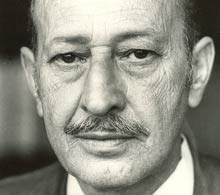CURRICULUM VITAE
Life of Stanislaw Szmajzner
Born in 1927 in Pulawy in Poland, he comes from a large religious family. Before being deported Stanislaw obtained food by engraving bullets for the Wehrmacht soldiers. He became a goldsmith at an early age. In 1939 Pulawy was one of the first towns in Poland to be made ‘Jew-free’.
All Jewish inhabitants were transferred to the ghetto of Opole, and transported from there to Sobibor. Szmajzner was then 15 years old. He realised after a few days that his entire family, apart from a brother and two cousins, had been exterminated. On his arrival he told SS-Oberscharfführer Gustav Wagner his profession was goldsmith. Wagner made him undergo a proficiency test. With good results. He managed to find work for his younger brother and cousins as well. Besides making jewellery for the SS-men, he had to overhaul prams which were brought by the incoming transports. He exchanged gold, which he could easily get hold of, for food and drink. Of all the survivors Szmajzner and Lerer were the first inmates incarcerated in the camp: from May 1942 until the revolt in October 1943.He was one of the very few ever to have contact with someone from Camp III, the gas chambers, whence no one ever returned. He was also a member of the secret committee. He sharpened the knives and axes which Feldhendler had filched. Stanislaw stole guns from the Ukrainians barracks, keeping one for himself and using it in the revolt against Ukrainians in the watch-towers.
On October 14th 1943, he fled with a group of roughly 100 people, including 8 Russians. The plan was to cross the river Bug and join the Russian partisans. When the Russians decided to go by themselves, he was the only one of the group who still had a gun. After wandering around in the woods for a week, having lost all sense of direction, they arrived again in the locality of the camp. They made contact with Polish partisans which turned out to be just as anti-Semitic as the Nazis. The Poles robbed the group and murdered 12 of Szmajzner’s comrades. He and two others were the only survivors. He joined the Russian partisans (“the best time of my life”) and hunted Nazis until the end of the war. After the war he served in the Polish army and took part in terrorist activities with a Zionist organisation which wanted to send people to Palestine.In 1947 he decided to emigrate to Israel, as far away from Poland as possible. First he left for Brazil to stay with members of his family, and remained there the rest of his life. He opened a jeweller’s shop in Rio de Janeiro, which after ten years became a flourishing company, married a Jewish Brazilian woman and started a family. With the advice and help from friends he bought a jungle island in the Amazon district and constructed a ranch there. He was one of the first white people which the local Indians had ever seen. After the Brazilian army seized power in 1967 Stanislaw sold the ranch out of fear of losing it. He moved to Goiania, where he became the director of a paper recycling factory. He wrote a book about Sobibor which he dedicated to the Brazilian people, whom he considered to be free of racism and prejudice. He was a member of a group dedicated to hunting out Nazis in Brazil and was involved in tracing henchmen Stangl and Wagner. He identified Wagner in a police-station in Rio de Janeiro and hinted that he was involved in Wagner's ‘suicide’.
He had a temperamental character and a flair for the theatrical. But at the same time Stanislaw Szmajzner has been averse to unnecessary publicity and boasting, displayed by other survivors at the preview of the docu-drama ‘Escape from Sobibor’ in 1987. He was fond of music, especially South American sambas, tangos, and boleros. The idea of revenge played a large role in his life.
Before he could see our finished documentary, Szmajzner died of a heart attack in 1989.
 Stanislaw Smajzner
Stanislaw Smajzner